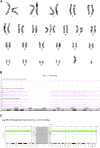Case report: A case report and literature review of complete trisomy 9
- PMID: 37719705
- PMCID: PMC10500842
- DOI: 10.3389/fgene.2023.1241245
Case report: A case report and literature review of complete trisomy 9
Abstract
Complete trisomy 9 is a rare and lethal chromosomal anomaly characterized by multisystem dysmorphism and central nervous system (CNS) malformations. This study presents a case of complete trisomy 9 with an unusual phenotypic association and investigates the genetic pathways involved in this chromosomal abnormality. Trisomy 9 leads to a wide range of organ abnormalities, and this research contributes to a better understanding of the phenotype associated with this rare aneuploidy. The literature on the phenotypes of fetuses with various systems affected by complete trisomy 9 was reviewed and summarized. Correct diagnosis and appropriate counseling based on the characteristics of previous reports of fetuses with trisomy 9 is essential in maternity care and clinical management. To provide guidance and help for clinical diagnosis, this study aimed to explore the clinical and genetic characteristics of trisomy 9 syndrome to improve clinicians' understanding of the disease.
Keywords: aneuploid; chromosomal disorder; complete trisomy 9; genetic counseling; prenatal diagnosis.
Copyright © 2023 Xu, Li, Peng, Zhang, Li, Zheng and Wang.
Conflict of interest statement
The authors declare that the research was conducted in the absence of any commercial or financial relationships that could be construed as a potential conflict of interest. The reviewer FX declared a shared affiliation with the author DW to the handling editor at the time of review.
Figures


Similar articles
-
Complete trisomy 9 with unusual phenotypic associations: Dandy-Walker malformation, cleft lip and cleft palate, cardiovascular abnormalities.Taiwan J Obstet Gynecol. 2014 Dec;53(4):592-7. doi: 10.1016/j.tjog.2014.01.005. Taiwan J Obstet Gynecol. 2014. PMID: 25510707
-
Prenatal diagnosis of complete trisomy 9: a case report and review of the literature.Am J Perinatol. 2006 Feb;23(2):131-5. doi: 10.1055/s-2006-931804. Am J Perinatol. 2006. PMID: 16506121 Review.
-
Latent class analysis applied to patterns of fetal sonographic abnormalities: definition of phenotypes associated with aneuploidy.Prenat Diagn. 1999 Sep;19(9):840-5. Prenat Diagn. 1999. PMID: 10521842 Clinical Trial.
-
[Karyotype analysis of amniotic fluid cells and comparison of chromosomal abnormality rate during second trimester].Zhonghua Fu Chan Ke Za Zhi. 2011 Sep;46(9):644-8. Zhonghua Fu Chan Ke Za Zhi. 2011. PMID: 22176986 Chinese.
-
Chromosomal abnormalities associated with neural tube defects (I): full aneuploidy.Taiwan J Obstet Gynecol. 2007 Dec;46(4):325-35. doi: 10.1016/S1028-4559(08)60002-9. Taiwan J Obstet Gynecol. 2007. PMID: 18182338 Review.
Cited by
-
Karyotyping with amniotic fluid in 6,572 pregnant women and pregnancy outcomes--A single-center retrospective study.PLoS One. 2025 May 20;20(5):e0324744. doi: 10.1371/journal.pone.0324744. eCollection 2025. PLoS One. 2025. PMID: 40392900 Free PMC article.
References
Publication types
LinkOut - more resources
Full Text Sources

